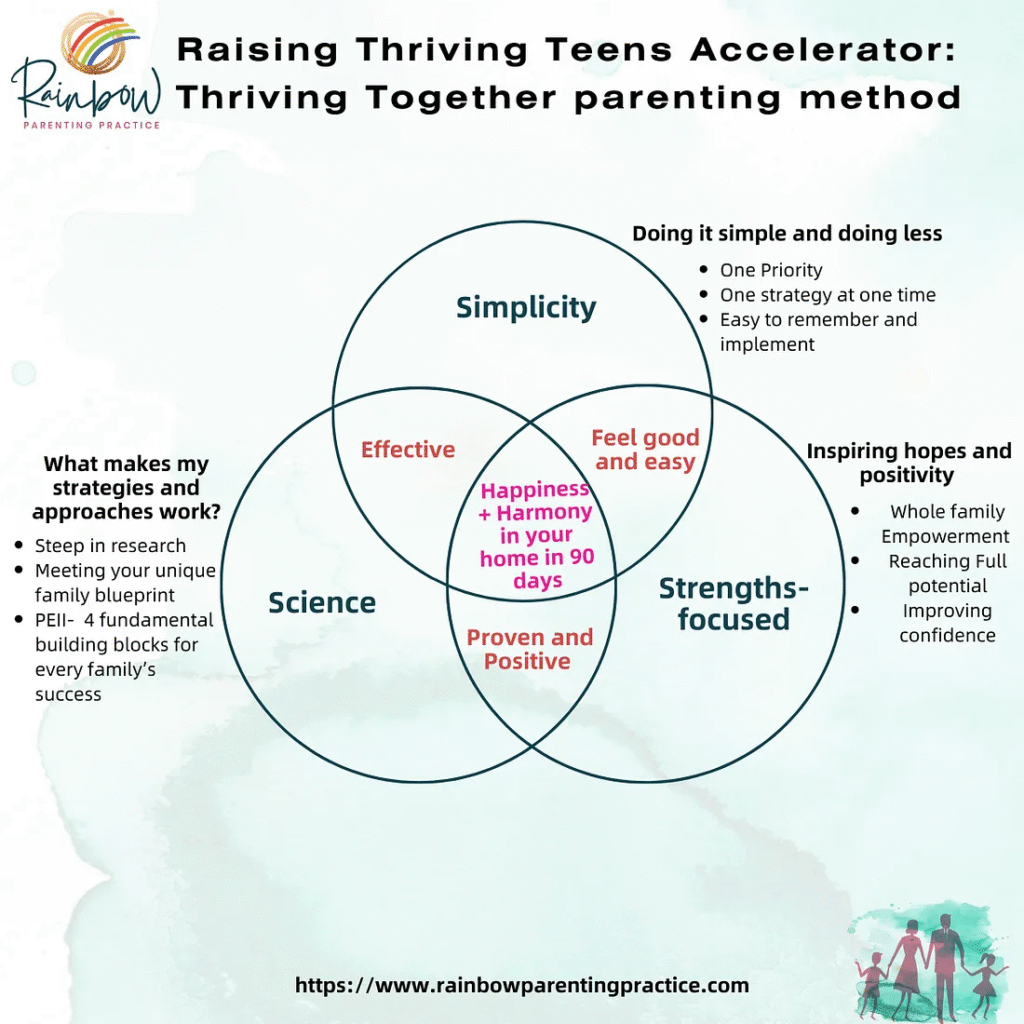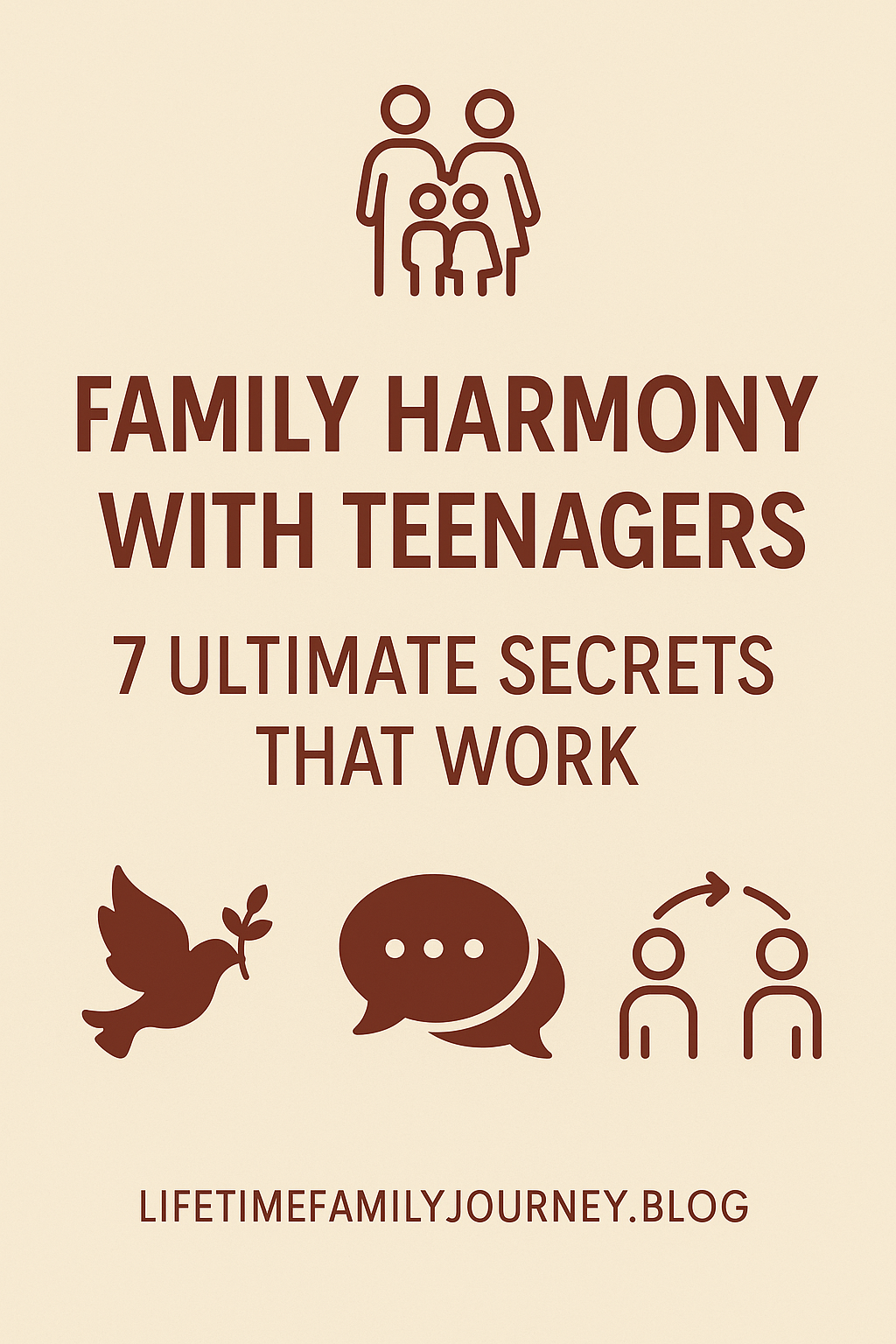Family Harmony with Teenagers: 7 Ultimate Secrets That Work
Let me paint you a picture that might sound familiar: It’s 6:30 PM on a Tuesday. You’ve just walked through the door after a long day, and before you can even set your keys down, you hear the unmistakable sound of your 16-year-old slamming their bedroom door. Again. Your 14-year-old is glued to their phone, ignoring your requests to come to dinner, and your spouse looks at you with that “here we go again” expression.

Sound like your house? 🏠
Here’s the thing – family harmony with teenagers isn’t some mythical unicorn that only exists in perfectly curated Instagram posts. It’s absolutely achievable, even when you’re dealing with mood swings, eye rolls, and the occasional “You just don’t understand me!” dramatic exit.
I’m a father of six kids (five girls and one boy), married for over 20 years, and an Air Force veteran. My wife teaches middle school math, so trust me when I say we’ve seen every teenage behavior in the book – both at home and in the classroom. We’ve weathered the storms of adolescence multiple times, and I’m here to share what actually works when it comes to maintaining family peace during these challenging but incredible years.
Why Family Harmony Matters More Than Ever During the Teen Years
The teenage years often get painted as this inevitable period of chaos and conflict. “Just wait until they’re teenagers,” people warn new parents with a knowing smirk. But here’s what I’ve learned through raising six kids and watching countless families navigate these waters: the teenage years can actually be some of the most rewarding and connected times in your family’s journey.
Research from JAMA Pediatrics consistently shows that family harmony has a significant relationship with adolescent stress levels, and teens who experience positive family dynamics report better mental health outcomes. When we create an environment of harmonious family relationships, we’re not just surviving the teenage years – we’re thriving through them.
The stakes are higher during adolescence because this is when your kids are forming their identity, making crucial decisions about their future, and honestly, when they need you most – even if they act like they don’t. Studies from the American Psychological Association reveal that 47% of teens say parents influence their decisions about important life choices more than friends, which means your voice still matters tremendously.
But here’s the catch: if your home feels like a battlefield, that influence diminishes rapidly. That’s why parenting teenagers peacefully isn’t just a nice-to-have – it’s essential for their development and your family’s well-being.

The Foundation: Understanding What Makes Teenagers Tick 🧠
Before we dive into strategies, let’s talk about what’s actually happening in your teenager’s brain. I wish someone had explained this to me with my first few kids – it would have saved us all a lot of frustration.
The teenage brain is literally under construction. The prefrontal cortex, which handles decision-making, impulse control, and considering consequences, isn’t fully developed until around age 25. Meanwhile, the limbic system – the emotional center – is in overdrive. This means your teenager is experiencing emotions more intensely than adults while having less capacity to regulate those emotions effectively.
This isn’t an excuse for poor behavior, but it’s crucial context for teenage family communication. When your 17-year-old has a meltdown over what seems like a minor issue, their brain is genuinely processing that situation as more intense than yours would.
Understanding this biological reality has completely changed how I approach conversations with teenagers. Instead of meeting intensity with intensity, I’ve learned to be the calm in their storm. This shift alone has improved our family harmony with teenagers dramatically.

The Communication Revolution That Changed Everything
Early in my parenting journey, I made a critical mistake that many parents make: I tried to parent teenagers the same way I parented young children. Big mistake.
With little kids, you can often use authority and consequences to guide behavior. With teenagers, you need to shift toward collaboration and respect. This doesn’t mean becoming their friend or abandoning boundaries – it means recognizing that they’re developing into independent adults and adjusting your approach accordingly.
Here’s what transformed our teenage family communication:
The LISTEN Method I developed:
- Lean in with your whole attention
- Inquire with genuine curiosity, not interrogation
- Summarize what you heard before responding
- Time your responses thoughtfully
- Empathize with their experience
- Navigate solutions together
This method has prevented countless conflicts in our home and created space for real connection. When teenagers feel heard and understood, they’re exponentially more likely to be open to guidance and cooperation.
Strategy #1: Create a Culture of Respect (Not Fear) 💪
One of the biggest mistakes I see parents make is ruling through fear and control. “Because I said so” might work with a 7-year-old, but it’s relationship poison with a 17-year-old.
Maintaining family peace requires mutual respect, and that starts with parents modeling the behavior they want to see. If you want your teenager to speak respectfully to you, you need to speak respectfully to them – even when you’re frustrated, tired, or disappointed.
This means:
- Knocking before entering their room
- Asking for their input on family decisions that affect them
- Acknowledging when you make mistakes or handle situations poorly
- Avoiding sarcasm, eye-rolling, or dismissive language
- Speaking about them positively to others (they will hear about it)

I remember a pivotal moment with my oldest daughter when she was 16. I had criticized her in front of her siblings about her messy room, and she called me out on it later. She was right – I had embarrassed her unnecessarily. I apologized genuinely, and that moment became a turning point in our relationship. She started trusting me with bigger things because she saw that I respected her enough to admit when I was wrong.
Respect is earned at every age, and teenagers have finely tuned radar for authenticity. They can smell fake respect from a mile away, but they’ll respond powerfully to genuine respect and consideration.
Strategy #2: The Art of Setting Boundaries Without Building Walls 🏗️
Boundaries with teenagers are crucial, but they need to be collaborative rather than dictatorial. The goal is harmonious family relationships, not a prison camp.
Here’s how we approach boundaries in our family:
The Three-Tier Boundary System
Tier 1: Non-Negotiables These are safety issues and core family values. Things like no drinking and driving, no drugs in the house, treating family members with basic respect. These boundaries are firm, clearly communicated, and consistently enforced.
Tier 2: Negotiables with Guidelines These include curfews, friend choices, social media usage, and similar issues. We involve our teenagers in setting these boundaries, explaining our concerns and listening to their perspectives. Often, they’ll suggest stricter guidelines than we would have imposed!
Tier 3: Their Choice Zone Room cleanliness (within reason), clothing choices, hobby pursuits, and other areas where we step back and let them exercise independence. This gives them space to make mistakes and learn from consequences without major life impact.
This system has eliminated most power struggles in our home because our teenagers understand the reasoning behind boundaries and have input into creating them. When enforcement becomes necessary, it’s not a personal attack – it’s simply following through on agreements we made together.

Making Consequences Learning Opportunities
When boundaries are crossed, the goal isn’t punishment – it’s learning. Natural consequences work much better than arbitrary punishments with teenagers.
For example, when one of my daughters consistently missed her curfew, instead of grounding her for a month, we had her research and present to the family about why curfews exist and what reasonable consequences should be for missing them. She ended up suggesting a graduated system that was actually stricter than what I had in mind, but she owned it because she created it.
This approach to parenting teenagers peacefully turns conflicts into collaborative problem-solving opportunities and strengthens family harmony with teenagers.
Strategy #3: Quality Time That Actually Connects 🎯
The biggest challenge with teenage family communication is that traditional “family time” often doesn’t work anymore. Teenagers are busy, they have their own interests, and frankly, family game night might not be their idea of fun.
But connection is still crucial – it just looks different.
Individual Connection Time
Each of my teenagers gets individual time with me regularly, doing something they enjoy. For one daughter, it’s coffee runs and talking about books. For another, it’s working on her car. For my son, it’s hiking or shooting hoops.
The key is following their interests, not imposing mine. These one-on-one times have become sacred in our family and are where the real conversations happen – about friends, fears, dreams, and everything in between.
The Power of Side-by-Side Activities
Teenagers often communicate better when they’re not under the pressure of face-to-face conversation. Some of our best talks happen while:
- Driving (they’re trapped and can’t escape! 😂)
- Cooking together
- Walking the dog
- Working on projects
- Shopping (yes, even with teenage boys)

Building healthy family routines around these activities creates natural opportunities for connection without the awkwardness of forced conversation.
Family Meals: The Connection Game-Changer
Research from The Family Dinner Project shows that regular family meals improve physical, mental, and emotional health. But with teenagers, you need to be strategic about how you approach family dinners.
We aim for five family meals together per week, but we’re flexible about which meals and what they look like. Sometimes it’s breakfast on Saturday morning, sometimes it’s late-night snacks while watching a movie. The key is being together, phones off, actually talking and listening to each other.
Strategy #4: Navigate Conflicts Like a Pro (Not a Drill Sergeant) ⚖️
Conflict with teenagers is inevitable. The goal isn’t to eliminate conflict – it’s to handle it in ways that strengthen rather than damage your relationship.
The Cool-Down Protocol
When emotions are running high, nobody makes good decisions. In our family, anyone can call a “cool-down” when a conversation is getting heated. This isn’t avoiding the issue – it’s choosing to address it when everyone can think clearly.
During cool-down time:
- Everyone goes to their own space
- We each think about our part in the conflict
- We return within 24 hours to discuss it calmly
- The focus is on solving the problem, not winning the argument
This simple protocol has prevented countless explosive fights and taught my kids valuable conflict resolution skills they’ll use their entire lives while maintaining family harmony with teenagers.
The Problem-Solving Partnership Approach
Instead of lecturing or imposing solutions, we approach conflicts as partners trying to solve a problem together. This might sound like:
“We have a problem. You want to go to Sarah’s party, and I’m concerned about the lack of adult supervision. How can we solve this together so you can have fun and I can feel confident about your safety?”
This approach invites collaboration instead of rebellion and often leads to creative solutions that work for everyone.
Strategy #5: Build Emotional Intelligence Together 🧠💗
One of the most valuable gifts you can give your teenager is emotional intelligence – the ability to understand, manage, and communicate about emotions effectively.
Emotional Vocabulary Building
Most teenagers (and adults!) have a limited emotional vocabulary. They know “mad,” “sad,” and “happy,” but emotions are much more nuanced than that.
We keep an emotions wheel on our refrigerator and regularly talk about the specific emotions we’re experiencing. Instead of “I’m mad,” we might say “I’m feeling frustrated and misunderstood.” This precision helps with teenage family communication because it gives everyone a clearer picture of what’s really going on.
Modeling Emotional Regulation
Your teenagers are watching how you handle your emotions more than you realize. When I’m stressed about work, frustrated with traffic, or disappointed about something, I try to verbalize my emotional process:
“I’m feeling really overwhelmed right now with everything I need to get done. I’m going to take a few deep breaths and prioritize my list so I can approach this more calmly.”
This modeling shows them that emotions are normal, manageable, and that there are healthy ways to process them.

Creating Emotional Safety
For family harmony with teenagers to flourish, your home needs to be emotionally safe. This means:
- Emotions are acknowledged, not dismissed
- Crying, anger, and frustration are met with empathy, not irritation
- Mistakes are learning opportunities, not reasons for shame
- Vulnerability is protected and honored
When teenagers feel emotionally safe at home, they’re more likely to come to you with problems instead of hiding them or seeking support elsewhere. According to research published in Developmental Psychology, adolescents who report high levels of family emotional support show significantly better outcomes across multiple life domains. This emotional safety is fundamental to family harmony with teenagers.
Advanced Strategies: When Traditional Methods Aren’t Enough 🚀
Sometimes, despite your best efforts, maintaining family peace requires more advanced strategies. Here are some approaches that have worked when we’ve faced more challenging situations.
The Reset Conversation
When relationships become strained, sometimes you need to hit the reset button. This involves having an honest conversation about what’s not working and what you both want to change.
I had to do this with one of my daughters when she was 15. Our relationship had become tense, with constant bickering and mutual frustration. I initiated a reset conversation:
“I don’t like how we’ve been interacting lately, and I don’t think you do either. I want us to have a better relationship. Can we talk about what’s not working and what we both want to change?”
That conversation led to some difficult but necessary changes in how we communicated, and our relationship transformed.
Professional Support When Needed
Sometimes parenting teenagers peacefully requires outside help, and there’s no shame in that. Family therapists, counselors, and parenting coaches can provide valuable tools and perspectives.
We’ve used professional support during particularly challenging seasons, and it made a tremendous difference. Having a neutral third party help navigate complex family dynamics can be incredibly valuable.
The Long Game Perspective
Remember that parenting teenagers is playing the long game. Some battles aren’t worth fighting, some phases will pass on their own, and some lessons can only be learned through experience.
I’ve had to learn to pick my battles carefully. Is this issue about safety, respect, or character? Then it’s worth addressing. Is it about preference, style, or independence? Maybe I need to let it go.
Creating Your Family’s Unique Harmony Blueprint 📋
Every family is different, and what works for one family might not work for another. The key is to take these strategies and adapt them to fit your family’s personality, values, and circumstances.

Start Small, Build Gradually
Don’t try to implement everything at once. Pick one or two strategies that resonate with you and focus on those until they become natural. Then gradually add more elements to your approach.
Regular Family Check-Ins
We have monthly family meetings where we discuss what’s working well and what needs adjustment. This keeps communication open and allows for course corrections before small issues become big problems.
These meetings include discussions about:
- Family routines that work and ones that need tweaking
- Upcoming events or challenges
- Individual and family goals
- Appreciation and acknowledgment
Flexibility is Key
What works for a 13-year-old won’t necessarily work for a 17-year-old. Be willing to adjust your approach as your teenagers grow and change. Harmonious family relationships require ongoing attention and adaptation.
The Role of Extended Family and Community 🏘️
Family harmony with teenagers doesn’t happen in isolation. Extended family, friends, teachers, coaches, and other adults in your teenager’s life all play important roles.
Building Your Village
Teenagers need multiple positive adult influences in their lives. Encourage relationships with:
- Grandparents and other family members
- Teachers and coaches who share your values
- Family friends who can provide different perspectives
- Mentors in areas of their interest
These relationships provide additional support and guidance while taking some pressure off the parent-child relationship.
Community Involvement
When teenagers are involved in positive community activities – sports, arts, volunteering, part-time jobs – they develop skills, confidence, and relationships outside the family. This often reduces family stress and gives them additional sources of support and identity.
Practical Daily Implementation 📅
The magic of maintaining family peace happens in the small, daily interactions more than in grand gestures or dramatic conversations.
Morning Routines That Set a Positive Tone
How your family starts the day often determines the tone for everything that follows. We’ve developed morning routines that promote connection rather than chaos:
- Everyone gets up 15 minutes earlier than “necessary” to avoid rushing
- We play upbeat music instead of starting with news or stress
- Each person shares one thing they’re looking forward to that day
- Physical affection (hugs, high-fives) is encouraged but not forced
Evening Wind-Down Practices
Evenings are crucial for teenage family communication because this is often when emotions and stress from the day surface.
Our evening practices include:
- A family dinner or snack time with phones put away
- Individual check-ins with each kid about their day
- Home cleaning tips that turn household maintenance into family teamwork
- Bedtime routines that include positive connection
Weekly Rhythm
Each week includes:
- One-on-one time with each teenager
- A family activity (movie, game, outing)
- Service or helping others together
- Planning and preparation for the upcoming week
This rhythm creates predictability and multiple opportunities for connection.
Navigating Specific Challenges 🎢
Let’s address some of the most common challenges parents face when trying to maintain harmonious family relationships with teenagers.
Technology and Screen Time
Technology is probably the biggest source of family conflict in the modern world. Instead of fighting against it, we’ve learned to work with it strategically.
Our family technology agreements include:
- Designated phone-free times and spaces
- Shared family streaming accounts with agreed-upon content standards
- Regular conversations about online safety and digital citizenship
- Involvement in their social media world without being invasive
Academic Pressure and Performance
School stress can create tremendous tension in families. We’ve learned to separate our worth (and theirs) from grades and achievements while still maintaining appropriate expectations.
This means:
- Focusing on effort and learning rather than just grades
- Providing support without doing the work for them
- Advocating for them when school situations are genuinely unfair
- Celebrating growth and improvement, not just perfection
Social Drama and Friendships

Teenage friendships are intense and ever-changing. As parents, our role is to provide guidance and support without trying to control their social world.
Strategies that have worked:
- Listening without immediately trying to fix or give advice
- Asking good questions that help them think through situations
- Sharing relevant experiences from our own teenage years
- Knowing when to intervene (safety issues) and when to step back
Future Planning and Independence
Teenagers are simultaneously excited about and terrified of growing up. This creates unique challenges around future planning and increasing independence.
We approach this by:
- Gradually increasing freedoms and responsibilities
- Having ongoing conversations about values, goals, and dreams
- Providing opportunities to practice adult skills in safe environments
- Supporting their interests even when they differ from our expectations
The Transformational Power of Unconditional Love ❤️
At the heart of family harmony with teenagers is unconditional love – love that doesn’t depend on behavior, achievements, or compliance.
This doesn’t mean unconditional approval of all choices or behaviors. It means your love for your teenager remains constant regardless of what they do or don’t do.
Teenagers test this constantly. They push boundaries, make mistakes, and sometimes behave in ways that are genuinely disappointing or concerning. But when they know that your love is secure and unchanging, they’re more likely to trust you with their struggles and more motivated to make positive choices.
Practical Ways to Communicate Unconditional Love

- Verbal affirmations that focus on who they are, not what they do
- Physical affection (appropriate to their comfort level)
- Showing up consistently, even when it’s inconvenient
- Defending them appropriately when others criticize
- Believing in their potential even when they don’t believe in themselves
When Families Face Major Challenges 🌪️
Sometimes families face major challenges that threaten harmonious family relationships – things like divorce, job loss, illness, addiction, or other serious issues.
During these times, maintaining family peace becomes even more crucial and more challenging. Achieving family harmony with teenagers during crisis requires extra intentionality and grace. Some strategies that have helped families we know navigate major difficulties:
Honest, Age-Appropriate Communication
Teenagers can handle more truth than we sometimes give them credit for. When families face major challenges, honest communication (appropriate to their developmental level) is usually better than secrets and evasion.
Professional Support
Major family challenges often require professional help. This might include family therapy, individual counseling, support groups, or other resources.
Maintaining Routines and Normalcy
When everything feels chaotic, maintaining some normal routines and family traditions provides stability and security.
Extra Grace and Flexibility
During difficult times, everyone needs extra grace. Standards might need to be temporarily adjusted, and extra patience and understanding are required from everyone.
The Long-Term Vision: Raising Future Adults 🌟

Parenting teenagers peacefully isn’t just about surviving the next few years – it’s about raising young people who will become healthy, happy, productive adults. This long-term perspective is essential for family harmony with teenagers.
This long-term perspective helps with daily decisions and interactions. Instead of asking “How do I get them to comply right now?” we ask “What does this young person need to learn to be successful as an adult?”
Essential Life Skills for Teenagers
While maintaining family harmony with teenagers, we’re also helping them develop crucial life skills:
- Emotional regulation and self-awareness
- Communication and conflict resolution
- Decision-making and problem-solving
- Time management and personal responsibility
- Financial literacy and practical life skills
- Relationship skills and empathy
- Resilience and adaptability
Preparing for Launch
The ultimate goal of harmonious family relationships is to launch young adults who are prepared for independence but who still want to maintain close family connections.
This means gradually shifting from control to influence, from managing their lives to consulting on their decisions, and from being their primary support system to being part of their broader support network.
Your Family’s Success Story Starts Today 🎯
Family harmony with teenagers isn’t a destination – it’s a journey. There will be good days and challenging days, victories and setbacks, moments of incredible connection and times when you wonder if you’re doing anything right.
The key is to keep showing up, keep learning, keep adjusting, and keep believing in the possibility of genuine harmony and connection with your teenagers.
Take Action Today
Start with these three simple steps:
- Choose one strategy from this guide that resonates with you and implement it this week
- Have a reset conversation with your teenager about what kind of relationship you both want
- Schedule regular one-on-one time with each of your teenagers
Remember, small consistent changes create big transformations over time.

Trust the Process
Parenting teenagers requires faith – faith in the process, faith in your relationship, and faith in your teenager’s ultimate potential. There will be times when it feels like nothing is working, when conflicts seem constant, and when you question everything you’re doing.
Keep going. Keep loving. Keep believing.
The teenage years can be some of the most rewarding and connected times in your family’s journey. When you approach them with intention, wisdom, and unconditional love, you’re not just surviving – you’re creating a foundation for lifelong relationships with your children.
Final Thoughts: The Gift of Grace 🙏
If I could leave you with one thought, it’s this: give yourself grace. Parenting teenagers peacefully is one of the hardest things you’ll ever do, and you won’t do it perfectly. None of us do.
But perfect isn’t the goal – connection is. Growth is. Love is.
Your teenagers don’t need perfect parents – they need real, authentic, loving parents who are willing to keep learning, keep growing, and keep showing up.
As a father who’s been through the teenage years multiple times and continues to navigate them with our youngest, I can tell you that the investment you make in family harmony with teenagers pays dividends for generations. The skills your teenagers learn about communication, conflict resolution, and healthy relationships will impact their future marriages, their parenting, and their ability to contribute positively to the world.
You’re doing important work. Keep going.
God Bless
I’m all about promotion of others so, if you like reading, you will enjoy this blog as well: https://familyfocusblog.com/
More from the Blog:
- Family Routines That Work – 7 Simple Fixes for a Calmer Day
- Unlocking VA Disability Process: 5 Proven Tips for Success
- Responsible Pet Ownership: 10 Truths Every Family Should Know🐶 🐱 🦜
🌐 Explore More from Our Family of Blogs
If you found this article helpful, you might also enjoy what we’re sharing across our other platforms. Each one is designed to uplift, equip, and inspire families in real, practical ways:
🏠 Mountains Will Move
Faith-based encouragement for everyday families. We dive into prayer, parenting, purpose, and pressing through life’s hardest seasons with Jesus at the center.
👉 Visit Mountains Will Move »
🔎 Everyday Exposed
Our no-filter truth hub—where we tackle myths, challenge misleading narratives, and bring clarity to the conversations that matter most.
👉 Visit Everyday Exposed »
Whether you’re diving deeper into pet care, faith, or uncovering truth in today’s noisy world, I hope you’ll journey with us.
Thank you for being part of the community. God Bless you and your family. 🙏


